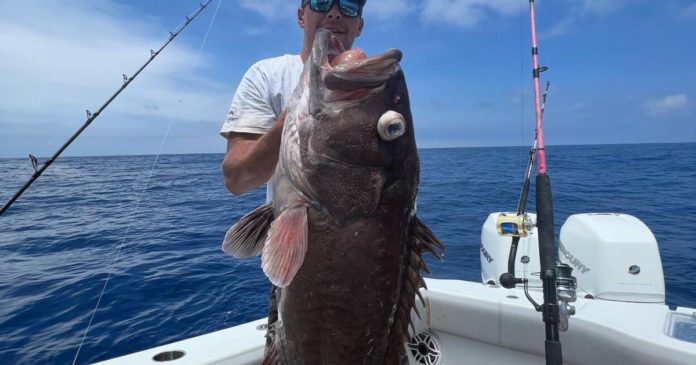Records are made to be broken, they say, but it’s not an everyday occurrence when it comes to fishing in South Carolina.
With more than 80 saltwater species and 30-plus freshwater species recognized in the state records program, it would seem there are plenty of opportunities.
But it takes a lot to overtake someone’s catch of a lifetime, and it doesn’t happen very often.
Saltwater fish that weigh under 50 pounds must beat the existing record by 4 ounces; fish that weigh between from 50 but not exceeding 100 pounds must bet the previous record by 8 ounces; and fish that weigh more than 100 pounds must exceed the previous record by 16 ounces.
Freshwater anglers trying to break an existing record with a catch under 25 pounds must exceed the previous mark by 2 ounces; freshwater fish weighing more than 25 pounds must exceed the existing record by at least 8 ounces.
If a catch doesn’t meet those requirements, it is considered a tie. And there are plenty of ties that can be found in the (dnr.sc.gov) records list. And, all fish submitted for record consideration must be examined by a S.C. Department of Natural Resources Department biologist.
The South Carolina Gamefish Record program began around 1970, although there are catches that pre-date the record-keeping program that have been recognized.
The oldest record catch is a 65-pound great barracuda caught in 1948 by Henry H. Shelor of Sumter, who was fishing out of Georgetown. The heaviest record is a 1,780-pound tiger shark caught by Walter Maxwell in 1964 off the Cherry Grove Fishing Pier.
There have been a couple of notable records established in 2022, the most recent being a snowy grouper caught June 10 by William Hartness while fishing aboard the boat Outnumbered out of Mount Pleasant.
Hartness’s catch weighed 36 pounds, 8 ounces, while the previous snowy grouper record was a 35-pound, 12.8-ounce catch by Christopher Cargill made two years ago.
“William said he knew it was a record the moment the fish was hooked. The captain and other anglers on the Outnumbered were thrilled to talk about the catch, too,” said Elizabeth Gooding, who heads up the saltwater fishing records program for the S.C. Department of Natural Resources.
“They asked great questions about the species and how we use the data that is collected. It’s these conversations that allow us to promote conservation and appreciation of our resources, and it is encouraging to see anglers interested in those aspects of the program.”
On the freshwater side, Chris Edlund of Spartanburg caught a 10-pound, 1.44-ounce walleye from Lake Tugaloo in Oconee County. But Edlund’s catch only shares the record with an even 10-pound catch made from Lake Russell in 1994, coming up a little more than a half-ounce shy of the needed weight.

If fish don’t surpass the previous record by a certain weight, the new catch is recognized as a tie. And there are plenty of ties in the records list.
Eight anglers share the record for the spot, a frequently caught inshore fish that doesn’t get very large. The initial record for spot was a 1-pound, 1-ounce catch made in 1967 that shares the mark with a 1-pound, 4-ounce catch made in 2001.
The most notable tie on the freshwater side is for largemouth bass with 16-pound, 2-ounce catches made in 1949 and in 1993 sharing the record.
In addition to meeting a weight standard, fish also have to be caught in a sporting manner, meaning only one angler using conventional rods and reels. And unlike the International Game Fish Association (IGFA), there are no line class records, no fly-fishing records, and no for male or female only records.
Fish have to be weighed on a state-certified scale and have to be inspected by a wildlife biologist in order to verify species. DNR biologists frequently have to burst the bubble of people who think they may have caught a record, but the species was misidentified.
Biologists often remove the otolith, a boney structure found in a fish’s inner ear which can be studied for aging purposes. Stomach contents also are studied. And the sex of the fish is determined. All of these studies help biologists in managing various fisheries.
The announcement of a catch being recognized for inclusion on the state records lists often results in a flurry of activity for a species.
Amy Dukes, who once handled the saltwater records program for SCDNR, said several years back that a golden tilefish record catch was made in May, that record was broken in June and then in July another record golden tile was landed.
The current record for golden tile, a deepwater, bottom-dwelling species, is a 28-pound, 3.2-ounce catch by Eddie Buck Jr. made in 2020.
There are saltwater record categories that are open and some that may never be broken.
The open categories include the smooth dogfish, spiny dogfish, yellowfin grouper, lionfish, ocean triggerfish and bigeye tuna. And because of either state or federal regulations, species including red drum, black drum, speckled hind grouper, Warsaw grouper, bigeye thresher shark, dusky shark, sandbar shark, sand tiger shark, silky shark and longbill spearfish are not eligible for new record consideration.
But breaking the record of one of the eligible species can put you in pretty heady company.
America’s Boating Club
America’s Boating Club Charleston will hold boating safety classes July 23 and Aug. 6 at 1376 Orange Grove Road, Charleston. The classes begin at 9 a.m. and end around 4 p.m. Successful participants earn the S.C. Department of Natural Resources Boater Education Card. The cost is $25 for adults and youth 12-18 are free. Call 843-312-2876 or email lynes@tds.net.
Credit: Source link































